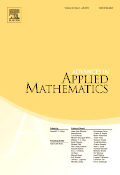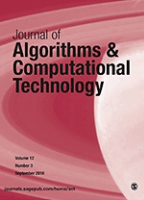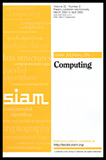
SIAM Journal on Mathematics of Data Science
Scope & Guideline
Elevating Data Science Through Rigorous Mathematical Approaches
Introduction
Aims and Scopes
- Mathematical Foundations for Data Science:
The journal emphasizes rigorous mathematical theories and frameworks that underpin data science methodologies, including statistical learning, optimization, and computational algorithms. - Statistical Inference and Machine Learning:
It publishes research on statistical methodologies that enhance machine learning models, including developments in deep learning, reinforcement learning, and probabilistic models. - High-Dimensional Data Analysis:
The journal covers techniques for analyzing high-dimensional data, focusing on scalability, efficiency, and the complexities introduced by large datasets. - Applications of Mathematical Models:
There is a strong focus on practical applications of mathematical models in various domains such as biology, finance, and social sciences, demonstrating the relevance of mathematical techniques to real-world problems. - Network Analysis and Graph Theory:
Research exploring the mathematical aspects of networks and graphs, particularly in relation to data science, is prominently featured, highlighting connections between structural properties and data-driven insights.
Trending and Emerging
- Deep Learning and Neural Network Innovations:
The journal has seen a surge in papers discussing advancements in deep learning architectures, optimization techniques, and their applications, indicating a strong interest in leveraging neural networks for complex data tasks. - Optimization Techniques for Machine Learning:
Emerging trends highlight a growing emphasis on optimization methods tailored for machine learning contexts, including adaptive methods, manifold optimization, and efficient algorithms for large-scale problems. - Generative Models and Their Applications:
Research on generative models, particularly Generative Adversarial Networks (GANs) and their applications in diverse fields, is increasingly prominent, showcasing the journal's alignment with current trends in AI. - Network and Graph-Based Learning Methods:
There is a notable increase in studies that explore graph-based learning techniques, reflecting the importance of network structures in data science and the need for specialized methodologies to analyze them. - Causal Inference and Structural Learning:
Recent publications indicate a rising trend in research related to causal inference methods, emphasizing the need for understanding relationships within data beyond mere correlations.
Declining or Waning
- Traditional Statistical Methods:
There is a noticeable decrease in publications centered around classical statistical methods, suggesting a shift toward more innovative or computational approaches in data science. - Low-Dimensional Data Techniques:
Research focusing on low-dimensional data analysis techniques has waned, likely due to the increasing complexity and volume of data that necessitates more sophisticated high-dimensional methodologies. - Basic Data Preprocessing Techniques:
The journal shows a decline in papers solely focused on basic preprocessing methods, indicating a shift towards more advanced and integrated approaches that consider the entire data science pipeline. - Linear Regression Models:
Although still relevant, traditional linear regression models are less frequently the focus of recent papers, possibly reflecting a broader movement towards more complex and non-linear modeling techniques. - Descriptive Statistics:
There has been a reduction in studies that primarily deal with descriptive statistics, as the field of data science increasingly favors inferential and predictive modeling.
Similar Journals

Journal of Applied Mathematics & Informatics
Transforming Ideas into Algorithms: Where Mathematics Meets Informatics.Journal of Applied Mathematics & Informatics is a peer-reviewed academic journal published by the Korean Society of Computational & Applied Mathematics (KSCAM), focusing on the integration and application of mathematical theories and computational techniques across various domains. Established in 2019, this journal serves as a platform for researchers, professionals, and students to share innovative methodologies, practical applications, and theoretical advancements in fields like analysis, applied mathematics, and computational theory. As a Q4 ranked journal according to the 2023 category quartiles in analysis, applied mathematics, computational mathematics, and miscellaneous mathematics, it provides a valuable, albeit niche, contribution to the academic landscape. While the journal currently operates without open access options, it aims to disseminate quality research to foster collaboration and knowledge exchange within the mathematics and computer science communities. Researchers looking to explore emerging trends and methodologies in applied mathematics and informatics will find an essential resource in this journal, which is based in Daejeon, South Korea.

ADVANCES IN APPLIED MATHEMATICS
Bridging Theory and Practice in Applied MathematicsADVANCES IN APPLIED MATHEMATICS, published by ACADEMIC PRESS INC ELSEVIER SCIENCE, is a prestigious journal that has served the mathematical community since 1980. With its ISSN 0196-8858 and E-ISSN 1090-2074, the journal is based in the United States, specifically in San Diego, CA. As a leading periodical in the field, it holds a notable Q2 ranking in Applied Mathematics and has been consistently ranked in the 43rd percentile among similar journals, illustrating its relevance and impact within the discipline. Although not an Open Access journal, ADVANCES IN APPLIED MATHEMATICS plays a crucial role in disseminating significant research findings, theoretical studies, and innovative applications of mathematics that address real-world problems. Researchers, professionals, and students alike will find valuable insights in its carefully curated publications, making it an essential resource for those looking to advance their understanding and application of mathematics.

CSIAM Transactions on Applied Mathematics
Fostering Interdisciplinary Collaboration in MathematicsCSIAM Transactions on Applied Mathematics is a prestigious academic journal published by GLOBAL SCIENCE PRESS, specializing in the rapidly evolving field of applied mathematics. Established in 2020 and operating in Hong Kong, this journal has quickly gained recognition for its rigorous peer-reviewed articles and contributions that integrate theoretical frameworks with practical applications. With an impressive ranking of #261 out of 635 in the Scopus database, and a 2023 quartile ranking of Q2 in Applied Mathematics, it is positioned to be a vital resource for researchers, professionals, and students alike. The journal offers a platform for innovative research that is essential for addressing contemporary challenges in science and engineering, promoting interdisciplinary collaboration and knowledge exchange. Although currently not Open Access, it provides invaluable insights through its curated content, truly reinforcing its role as a cornerstone in the field of applied mathematics.

Journal of Algorithms & Computational Technology
Pioneering Discoveries in Numerical Analysis and BeyondJournal of Algorithms & Computational Technology, published by SAGE PUBLICATIONS LTD, serves as a noteworthy platform for scholars and practitioners in the realms of applied mathematics, computational mathematics, and numerical analysis. With an ISSN of 1748-3018 and an E-ISSN of 1748-3026, this Open Access journal has been disseminating high-quality research since 2007, ensuring that significant advancements in algorithmic techniques and computational methodologies are readily accessible to the global academic community. Based in the United Kingdom, this journal has steadily established itself within specialized quartiles, notably achieving Q3 ranking in Computational Mathematics and Q4 in both Applied Mathematics and Numerical Analysis for 2023, reflecting its growing influence in these fields. As the journal converges from 2011 to 2024, it aims to cater to the needs of researchers, professionals, and students by publishing innovative research that not only addresses theoretical frameworks but also provides practical applications. By leveraging its open-access model, the Journal of Algorithms & Computational Technology fosters a collaborative environment where knowledge can flourish, allowing for the continuous evolution of algorithms that drive technological advancement.

SIAM JOURNAL ON COMPUTING
Catalyzing Innovative Solutions to Computational Challenges.Welcome to the SIAM Journal on Computing, a premier publication of SIAM Publications dedicated to advancing the field of computational science. Established in 1984, this journal provides a platform for groundbreaking research and theoretical advancements that shape the landscape of both Computer Science and Mathematics. With an impressive impact factor and consistently ranking in Q1 quartiles for its categories, the journal remains an essential resource for scholars looking to contribute to innovative computational theories and methodologies. Although not currently an open-access journal, the SIAM Journal on Computing offers rigorous peer-reviewed articles, ensuring high-quality contributions that appeal to researchers, professionals, and students alike. As we converge towards 2024, this journal continues to play a vital role in influencing future research directions and fostering an academic community devoted to the exploration of computational challenges. Join us in exploring the forefront of computing research!

Results in Mathematics
Pioneering Discoveries in Applied and Theoretical Mathematics.Results in Mathematics, published by SPRINGER BASEL AG, is a prestigious academic journal dedicated to advancing the field of mathematics since its inception in 1978. Based in Switzerland, this journal has garnered a significant reputation, holding a Q2 ranking in both Applied Mathematics and miscellaneous Mathematics categories according to the latest 2023 metrics. The journal is a vital resource for researchers, professionals, and students, encouraging open dialogue about emerging mathematical concepts and methodologies. Our editorial objective is to publish high-quality research articles that contribute to theoretical advancements and practical applications in mathematics. Although it does not currently offer open access options, it provides in-depth studies and articles that fortify the knowledge base within the mathematical community. With a commitment to innovation and academic rigor, Results in Mathematics continues to serve as an essential platform for scholarly communication and exploration.

Communications for Statistical Applications and Methods
Empowering Researchers with Practical Statistical SolutionsCommunications for Statistical Applications and Methods is a vital academic journal dedicated to advancing the field of statistics, with a particular focus on practical applications and methodologies. Published by the Korean Statistical Society, this journal has become a significant resource for researchers, practitioners, and students engaged in statistical sciences and its diverse applications in various fields including finance and modeling. Operating without an Open Access format, the journal is accessible through institutional subscriptions, allowing a broad audience to benefit from its insights. The journal covers works from its inception in 2017 to 2024, and although it currently ranks in the Q4 and Q3 quartiles across various mathematical and statistical categories, its commitment to quality research makes it a noteworthy platform for emerging trends and innovations. The journal not only serves to disseminate knowledge but also fosters collaboration among statisticians, ensuring that crucial advancements in statistical applications are communicated effectively.

International Journal of Mathematics and Computer Science
Advancing the Frontiers of Mathematics and Computer ScienceThe International Journal of Mathematics and Computer Science (ISSN: 1814-0424, E-ISSN: 1814-0432), published by Lebanese University, serves as a vital platform for disseminating innovative research and advancements in the fields of mathematics and computer science. With a compelling range of topics including Algebra, Applied Mathematics, Computational Mathematics, and Statistical Analysis, this journal caters to a broad audience of researchers, professionals, and students. Spanning the years from 2017 to 2025, it has established a presence in several key quartiles, including Q3 rankings in Applied Mathematics and Computational Mathematics, and a Q4 ranking in Algebra and Number Theory. While currently not an open-access journal, it provides valuable insights through its rigorous peer-reviewed process, enhancing its relevance in both theoretical and applied domains. Furthermore, its presence in Scopus rankings reflects its commitment to quality, making it an essential resource for anyone looking to explore the intersection of mathematics and computer science.

Mathematical Foundations of Computing
Catalyzing Innovation in Artificial Intelligence and BeyondMathematical Foundations of Computing, published by the American Institute of Mathematical Sciences (AIMS), is a distinguished open-access journal that has been actively disseminating influential research in the fields of Artificial Intelligence, Computational Mathematics, Computational Theory and Mathematics, and Theoretical Computer Science since its inception in 2009. With its E-ISSN 2577-8838, this journal is committed to providing researchers and practitioners with cutting-edge mathematical theories and methodologies that underpin modern computational practices, which is critical for advancing the field. The journal proudly holds a Q3 categorization in several relevant domains as of 2023, reflecting its contribution and accessibility amid an evolving academic landscape. By offering open access to its content, it ensures that vital research is freely available to a global audience, enhancing collaboration and innovation. Positioned in the heart of the United States, Mathematical Foundations of Computing serves as a crucial resource for advancing knowledge and fostering discussions among researchers, professionals, and students passionate about the mathematical underpinnings of computing.

Vestnik Sankt-Peterburgskogo Universiteta Seriya 10 Prikladnaya Matematika Informatika Protsessy Upravleniya
Bridging Theory and Practice in Applied Mathematics and Computer ScienceVestnik Sankt-Peterburgskogo Universiteta Seriya 10 Prikladnaya Matematika Informatika Protsessy Upravleniya, published by ST PETERSBURG UNIV PRESS, stands as a notable contribution to the fields of applied mathematics, computer science, and control processes. With an ISSN of 1811-9905 and an E-ISSN of 2542-2251, this journal seeks to provide a platform for innovative research and scholarly discussions, bridging theoretical concepts and practical applications. Although it currently has no Open Access option, the journal's rigorous peer-review process ensures the dissemination of high-quality research. As reflected in its Scopus rankings, it is positioned in the Q4 quartile in Applied Mathematics and Control and Optimization, and Q3 in General Computer Science, thereby fostering a vibrant academic dialogue among researchers, professionals, and students. The journal encompasses a rich scope that encourages contributions aimed at enhancing the methodologies and tools crucial for advancements in these interconnected disciplines, particularly as it continues to evolve from 2017 to 2024. By nurturing interdisciplinary collaboration, Vestnik Sankt-Peterburgskogo Universiteta remains an essential resource for those engaged in the complexities of mathematical and computational problems.